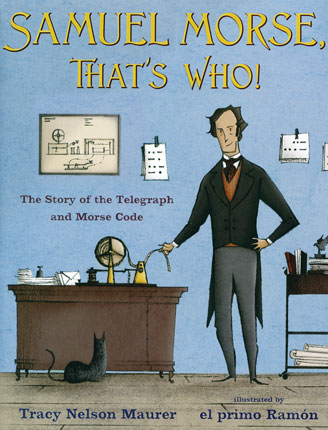| Samuel Morse, that's who! Author: Maurer, Tracy | ||
| Price: $6.50 | ||
Summary:
A picture book biography of Samuel Morse that highlights how he revolutionized modern technology.
| Illustrator: | Primo Ramon |
| Accelerated Reader Information: Interest Level: LG Reading Level: 4.10 Points: .5 Quiz: 503558 | Reading Counts Information: Interest Level: K-2 Reading Level: 3.30 Points: 1.0 Quiz: 77228 | |
Reviews:
Kirkus Reviews (04/15/19)
School Library Journal (06/01/19)
Booklist (06/01/19)
The Bulletin of the Center for Children's Books (00/06/19)
The Hornbook (00/09/19)
Full Text Reviews:
School Library Journal - 06/01/2019 Gr 1–2—Who makes a great topic of a picture book biography? Samuel Morse, that's who! Maurer tells the story of Morse's invention of the telegraph and Morse code in an engaging, light text. Pencil-line drawings with digital coloring by Ramón convey a strong sense of time and place, and the heavy use of white space makes the layout appealing for young readers. Maurer begins by emphasizing some of Morse's failed endeavors, including unsuccessful inventions and his passion to become an artist. While Morse enjoyed painting, he was never critically successful; however, in his travels to become a better artist, he discovered the French optical telegraph system, which inspired the telegraph and Morse code. He eventually turned his focus to his invention and the development of a U. S. telegraph line. The simple text provides relevant connections for students in its portrayal of great success spawned from failure and revision of plans and ideas. Endpapers include a time line of Morse's life, facts about the telegraph, an extensive bibliography, and an author's note that connects Morse's code to the modern binary language of computers. VERDICT This is an excellent biography on a lesser-known figure; add to collections looking for inventors and makers. As it turns out, … amuel M - - - r … e was a predecessor of the maker movement.—Jamie Jensen, Wayne Cox Elementary School, Roanoke, TX - Copyright 2019 Publishers Weekly, Library Journal and/or School Library Journal used with permission.
Booklist - 06/01/2019 Samuel Morse wasn't quite an instant success. He wanted to be a painter, but when his career in America didn't take off, he sailed to England in 1829 to study. People still didn't seem to get his art when he returned, but they sure were interested in the electromagnetic system to carry coded messages that he'd designed on the voyage home . It took trial and lots of error, but eventually Morse developed Morse code and the telegraph, allowing news that had previously taken months to travel across countries in a blink. Maurer follows up her noted John Deere, That's Who! (2017) with another accessible exploration of an instrumental figure in STEM. Ramón's illustrations, sometimes tongue-in-cheek, complement the breezy tone as they map Morse's journey. The extensive back matter includes a time line and additional resources, and readers curious about Morse code, discussed briefly in the text, should check under the book's jacket (a feature that may be lost in libraries if the jacket is laminated down). A fun, informative way to tap into historical inventions. - Copyright 2019 Booklist.



